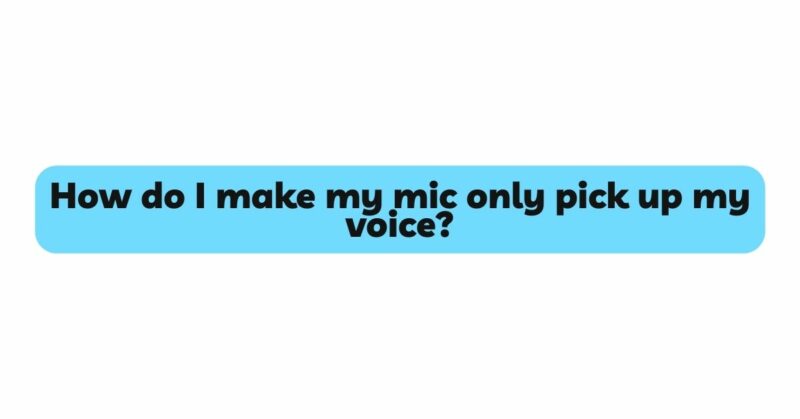In today’s digital age, microphones have become an indispensable tool for various activities such as podcasting, video conferencing, content creation, and more. However, achieving optimal audio quality can sometimes be challenging, especially when dealing with background noise and unwanted audio interference. One common concern is ensuring that your microphone captures only your voice, minimizing distractions caused by ambient sounds. This article delves into the intricacies of microphone setup and techniques that can help you make your microphone focus exclusively on your voice, resulting in crisp and clear audio recordings.
1. Microphone Selection
The journey toward capturing your voice clearly begins with choosing the right microphone. Dynamic microphones are often preferred for voice capture due to their inherent ability to reject ambient noise. Condenser microphones, on the other hand, tend to be more sensitive and may pick up more background noise. Therefore, when striving for isolated voice capture, consider using a dynamic microphone like the Shure SM7B or Electro-Voice RE20.
2. Microphone Placement
Proper microphone placement plays a crucial role in isolating your voice from unwanted sounds. Position the microphone as close to your mouth as possible without causing plosives (popping sounds caused by air bursts), typically around 4-6 inches away. Using a pop filter or windscreen can help reduce plosives and further isolate your voice.
3. Acoustic Environment
Recording in a controlled acoustic environment can significantly enhance voice isolation. Choose a room with minimal echo and reverb. Consider using acoustic treatment, such as foam panels, bass traps, and diffusers, to reduce reflections and background noise. If possible, record in a carpeted room with curtains, cushions, and soft furnishings to absorb sound.
4. Noise Reduction Tools
Digital audio workstations (DAWs) offer various tools to enhance voice isolation during post-production. Noise reduction plugins, such as iZotope RX or Adobe Audition’s noise reduction feature, can help eliminate background noise without affecting the quality of your voice. However, use these tools judiciously, as excessive noise reduction might lead to unnatural artifacts in your recording.
5. Directional Microphone Patterns
Microphones come with different directional pickup patterns, each affecting how they capture sound. Cardioid microphones capture sound primarily from the front and reject sound from the sides and rear. This pattern is ideal for isolating your voice from surrounding noise. Bidirectional and shotgun microphones are also options, depending on your recording environment and requirements.
6. Noise Gates
Noise gates are tools that can be employed to cut off audio below a certain threshold. By setting an appropriate threshold level, a noise gate can effectively mute or reduce the volume of background noise when you’re not speaking. This tool can be especially useful during pauses in your speech, helping maintain a clean and focused audio track.
7. Microphone Preamp and Gain Settings
Adjusting your microphone preamp and gain settings correctly can also contribute to improved voice isolation. Set the gain to an appropriate level where your voice comes through clearly without needing to boost the signal excessively. Over-amplifying the signal can result in background noise being amplified as well.
8. Use of Headphones
Wearing headphones while recording can prevent the microphone from picking up audio from your computer’s speakers. This is particularly relevant for remote interviews or recording sessions where you’re interacting with others through video conferencing software.
9. Record in a Controlled Time
Select a time for recording when external noises are at a minimum. This might mean avoiding rush hours, construction times, or other sources of disturbances. A quiet recording environment sets the stage for better voice isolation.
10. Post-Recording Editing
After recording, it’s essential to review your audio and make any necessary edits. Trim sections with background noise or unwanted sounds, and apply mild compression and equalization to enhance your voice while maintaining a natural sound.
Conclusion
Capturing clear and isolated voice recordings involves a combination of choosing the right microphone, optimizing its placement, creating a suitable recording environment, and utilizing both hardware and software tools effectively. By following the guidelines outlined in this article, you’ll be well-equipped to ensure that your microphone captures only your voice, resulting in professional-quality audio that stands out in any context, from podcasting to online presentations. Remember that practice and experimentation will further refine your techniques, allowing you to achieve exceptional voice isolation with every recording.

